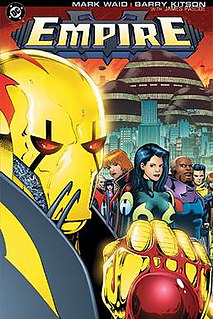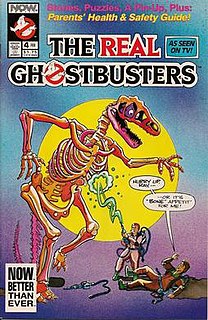
John Lindley Byrne is a British-born American writer and artist of superhero comics. Since the mid-1970s, Byrne has worked on many major superheroes; with noted work on Marvel Comics' X-Men and Fantastic Four. Byrne also facilitated the 1986 relaunch of DC Comics' Superman franchise, the first issue of which featured comics' first variant cover. Coming into the comics profession as penciller, inker, letterer and writer on his earliest work, Byrne began co-plotting the X-Men comics during his tenure on them, and launched his writing career in earnest with Fantastic Four. During the 1990s he produced a number of creator-owned works, including Next Men and Danger Unlimited. He scripted the first issues of Mike Mignola's Hellboy series and produced a number of Star Trek comics for IDW Publishing. In 2015, Byrne and his X-Men collaborator Chris Claremont were entered into the Will Eisner Award Hall of Fame.

Action Comics is an American comic book/magazine series that introduced Superman, one of the first major superhero characters. The publisher was originally known as National Allied Publications, and later as National Comics Publications and as National Periodical Publications, before taking on its current name of DC Comics. Its original incarnation ran from 1938 to 2011 and stands as one of the longest-running comic books with consecutively numbered issues. The second volume of Action Comics beginning with issue #1 ran from 2011 to 2016. Action Comics returned to its original numbering beginning with issue #957.

Walt Disney's Comics and Stories, sometimes abbreviated WDC&S, is an American anthology comic book series featuring characters from The Walt Disney Company's films and shorts, including Donald Duck, Scrooge McDuck, Mickey Mouse, Chip 'n Dale, Li'l Bad Wolf, Scamp, Bucky Bug, Grandma Duck, Brer Rabbit, Winnie the Pooh, and others. With more than 700 issues, Walt Disney's Comics & Stories is the longest-running Disney comic book in the United States, making it the flagship title, and is one of the best-selling comic books of all time.
Amazing Adventures is the name of several anthology comic book series, all but one published by Marvel Comics.
Godzilla has appeared in a range of comic books that have been published in Japan and the United States.
There have been three main publishers of the comic book series bearing the name Transformers based on the toy lines of the same name. The first series was produced by Marvel Comics from 1984 to 1991, which ran for 80 issues and produced four spin-off miniseries. This was followed by a second volume titled Transformers: Generation 2, which ran for 12 issues starting in 1993. The second major series was produced by Dreamwave Productions from 2002 to 2004 with multiple limited series as well, and within multiple story continuities, until the company became bankrupt in 2005. The third and fourth series have been published by IDW Publishing with the third series starting with an issue #0 in October 2005 and a regular series starting in January 2006 to November 2018. The fourth series started in March 2019 with issue #1 and is currently still being produced. There are also several limited series being produced by IDW as well. In addition to these three main publishers, there have also been several other smaller publishers with varying degrees of success.

Darwyn Cooke was a Canadian comics artist, writer, cartoonist, and animator who worked on the comic books Catwoman, DC: The New Frontier, The Spirit and Richard Stark's Parker: The Hunter. His work has been honoured with numerous Eisner, Harvey, and Joe Shuster Awards.

Steve Niles is an American comic book author and novelist, known for works such as 30 Days of Night, Criminal Macabre: A Cal McDonald Mystery, Simon Dark, Mystery Society, and Batman: Gotham County Line.

G.I. Joe has been the title of comic strips and comic books in every decade since 1942. As a licensed property by Hasbro, G.I. Joe comics have been released from 1967 to present, with only two interruptions longer than a year. As a team fighting Cobra since 1982, the comic book history of G.I. Joe: A Real American Hero has been covered by three separate publishers and four main-title series, all of which have been based on the Hasbro toy line of the same name.

Empire is an American comic book limited series created by Mark Waid and Barry Kitson. It was published between 2000 and 2004 by Gorilla Comics and DC Comics, then sold to Thrillbent and IDW Publishing in 2015.
Mark D. Bright is an American comic book and storyboard artist. Sometimes credited as Doc Bright, he is best known for pencilling the Marvel Comics Iron Man story Armor Wars, the two Green Lantern: Emerald Dawn miniseries for DC Comics, for painting the cover to Marvel Comics' Transformers #5 and for co-creating Quantum and Woody with writer Christopher J. Priest. Bright later became a freelance storyboard artist, although he and Priest reunited for a five-issue Quantum and Woody miniseries published by the new incarnation of Valiant Comics in 2014–2015, but set in the continuity of the original Quantum and Woody series.

History of the DC Universe is a two-issue comic book limited series created by writer Marv Wolfman and artist George Pérez which was published by DC Comics following the end of Crisis on Infinite Earths.
Kieron Dwyer is an American comics artist. He is best known for his work for Marvel Comics and DC Comics as well as for his creator-owned projects.
This is a list of comics regarding the Star Trek media franchise.

Fantastic Four is the name of several comic book titles featuring the team Fantastic Four and published by Marvel Comics, beginning with the original Fantastic Four comic book series which debuted in 1961.

The Ghostbusters franchise spawned various comic books published by various comic book companies through the years starting in 1988 and continuing to the present day. These comics have ranged from being based on The Real Ghostbusters animated series, to the 1984 film.
Star Trek is a comic book series by IDW Publishing, based on the Star Trek science fiction entertainment franchise created by Gene Roddenberry. Since 2007, IDW Publishing has released three Star Trek ongoing series along with many limited series, crossover series and annuals.

IDW Publishing, an American comic publisher which has been publishing tie-in comic books to Hasbro properties since 2005, began to publish monthly My Little Pony comics beginning in November 2012. The comics published so far are based on the characters from the 2010 relaunch of the franchise and its television series My Little Pony: Friendship Is Magic, as well as the anthropomorphic spin-off Equestria Girls. The flagship monthly publication, My Little Pony: Friendship Is Magic, is accompanied by a secondary monthly title. In addition to these publications, IDW has also published several one-off issues.

Sonic the Hedgehog is an ongoing American comic book series based on the Sega video game franchise, published by IDW Publishing. It is the third licensed comic book iteration based on Sega's Sonic the Hedgehog intellectual property, after Fleetway Publications' Sonic the Comic and Archie Comics' Sonic the Hedgehog series.












